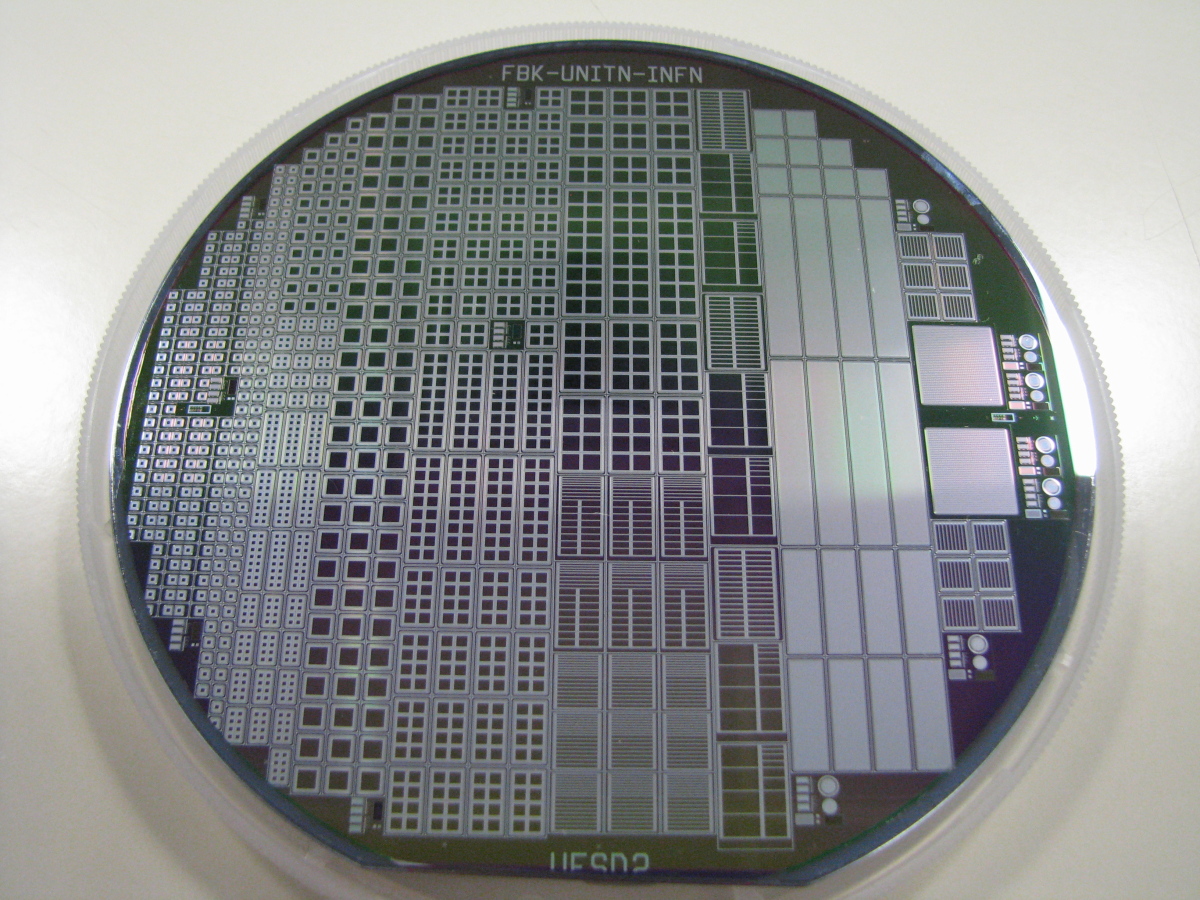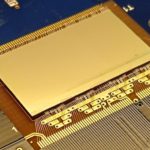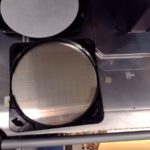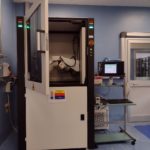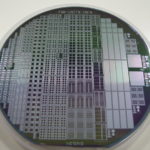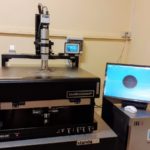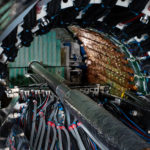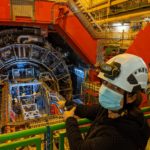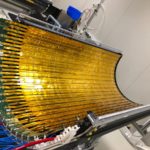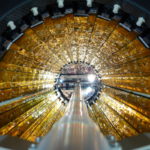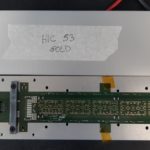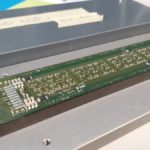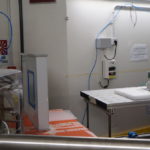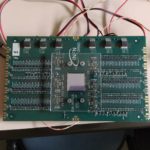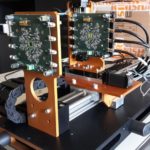Main description of WP1/b activities
WP coordinator: A. Chiavassa
The WP1 can be internally divided in two main research lines:
- a) advanced materials and new devices
- b) development and application of silicon based particle detectors
–> For the main description of WP1/a description ref. to available material collected by P. Olivero
The main goal of WP1b is instead to develop innovative sensors and electronics for applications in medical Physics, high-energy nuclear and particle Physics experiments at accelerators and astro-particle Physics, aiming to advance the state-of the art in silicon sensors and related readout electronics.
Description of sub-activities and list of publications aknowledging the ED
High-Energy Physics at accelerators
Project description
In the field of high energy Physics at accelerators the Excellence Department is involved in two main upgrade projects of the CMS (Compact Muon Solenoid) experiment for the High-Luminosity Large Hadron Collider (HL-LHC) at CERN.
CMS Phase2 pixel upgrade for HL-LHC
Contacts
E. Migliore, L. Pacher, N. Demaria (INFN)
The first project is focused on the design and construction of the new silicon pixel detector that will operate at HL-LHC.
The new pixel detector will be a crucial component for pattern recognition and track reconstruction under unprecedented particle fluxes and radiation levels foreseen at HL-LHC.
In this project the University of Torino, in strong collaboration with INFN, is primarily involved in the design of the new pixel readout chip (ROC) using a commercial 65nm CMOS technology within the framework of the CERN/RD53 collaboration.
A first full-size prototype (order of 2cm x 2cm) of the new pixel readout chip, named RD53A, has been submitted and extensively characterized in 2018-2019. Different architectures of analog front-end and digital pixel readout logic were developed inside the international collaboration RD53 and in May 2019 the final front-end architecture was chosen by the CMS collaboration opening up the phase of the design of the final chip, now referred to as C-ROC (CMS Read-Out Chip). A first pre-production version of this chip, containing all required functionalities to operate in the final system has been submitted in Februrary 2020 and succesfully tested through 2020-2021. Design activities of the final version of the chip are ongoing, with the production submission foreseen for end of 2022. The main features of this extremely sophisticated chips are: radiation tolerance up to 1 Grad TID, low power dissipation (1 W/cm2), low noise occupancy (10-6 at 1200 e– threshold), high hit rate (3 GHz/cm2) and trigger rate (1 MHz with 12.5 μs trigger latency) capabilities.
Beside developments in the design and characterization of the new pixel readout electronics the University of Torino, in collaboration with the Torino Section of INFN, is in charge of the assembling of the entire innermost barrel layer of the new CMS pixel detector. This activity involves the design of all mechanical components, the qualification and test of hundreds silicon wafers containing the final readout chip through wafer-level testing (WLT), the qualification of assembled modules containing the readout chips bump-bonded to hybrid silicon detectors and the assembling of the final barrel layer for the new pixel detector.
Thanks to Excellence Department founding resources, in collaboration with the INFN Torino, this project greatly benefits from the installation of a new professional semi-automatic wafer probe station Cascade Microtech CM300xi and of a new X-ray facility, both installed, commissioned and operating in the technological laboratory of INFN Torino.
This has allowed to start the calibration of the automated wafer testing procedure with the CM300 probe station that will be finalized using wafers from the next engineering run. Moreover, after the initial commissioning of the X-ray machine, started in January 2022, Univerisity of Torino will be also able to perform Total-Ionizig Dose (TID) irradiation tests on submitted ASICs.
Publications mentioning the ED
RD53 analog front-end processors for the ATLAS and CMS experiments at the high-luminosity LHC
PoS (VERTEX2019) 021.
DOI: 10.22323/1.373.0021 Scopus: 2-s2.0-85091656281
Conference talks/posters mentioning the ED
n/a
PhD theses
Development and characterization of innovative readout electronics for pixel detectors at HL-LHC
Michael Grippo, Dottorato di Ricerca in Fisica, XXXVI ciclo. Borsa di studio finanziata dal MIUR nell’ambito del progetto Dipartimento di Eccellenza
Post-graduate degree (LM) theses
Sviluppo di procedure di test per l’ASIC RD53B per l’upgrade dell’Inner Tracker dell’esperimento CMS per HL-LHC
Fabio Luongo, Laurea Magistrale in Fisica, 2021
Undergraduate (LT) theses
Studio della risposta di sensori a pixel di silicio per l’upgrade dell’esperimento CMS
Isabella Sofia, Laurea in Fisica, 2020
Sviluppo di un sistema di monitoraggio di temperatura e umidita` basato su BeagleBone Black
Fabio Luongo, Laurea in Fisica, 2019
Ultra-Fast Silicon Detectors and readout electronics for particle tracking
Contacts
M. Costa, A. Solano; N. Cartiglia (INFN), V. Sola (INFN)
The second project involves the design, qualification and construction of the innovative MIP Timing Detector that will installed in the CMS experiment for HL-LHC. The new detector will allow to add high-resolution timing information for particle tracking over a wide pseudorapidity range in order to greatly reduce trigger rates under unprecedented pile-up conditions at HL-LHC.
The new detector is divided in a Barrel part and in two Endcap. The sensor technology that has been chosen in September 2019 by the CMS Collaboration to be used in the Endcap (almost 15 m2) is based on is based on the usage of Ultra-Fast Silicon Detectors (UFSD), an innovative detector technology with a long research tradition at University and INFN of Torino already started inb 2016 in sinergy with the CERN/RD50 collaboration.
UFSD detectors are based on the Low-Gain Avalanche Diode (LGAD) concept and optimized for timing in high-energy physics and medical physics applications. Different productions have been studied within this project. The main goal is to reach better than 40 ps timing resolution up to 1.5 x1015 neq cm-2 s-1. Few vendors are on the market: Hamamatsu (Japan), Fondazione Bruno Kessler (Italy), NDL (China), CNM (Spain). The Torino UFSD group has connections with all of them: in particular with FBK a strong collaboration is ongoing. In 2018 the main FBK production has been focused on the use of Carbon in the gain layer implantation to mitigate radiation effects and to preserve the timing resolution at high dose, and on the lithography technique to get sensors of large dimensions, typically 4 x 24 pads 3 mm2 each.
In 2019 a couple of new batch productions systematically addressed how to minimize the inter-pad regions in order to limit the sensor dead area and to optimize the p-stop doping to get better performances. Moreover the sensor geometries have been designed to properly match the front-end electronics in order to perform an appropriate system test. In this context Torino also actively contributed to the sensor design and optimization using professional Technology CAD (TCAD) simulation tools.
Beside the sensor design and characterization activities, the UFSD group in Torino, in collaboration with the INFN Torino ASIC design laboratory, is working on the development of custom front-end electronics for the readout of these sensors, aiming at applications that require very precise time tagging. An innovative low-power 20-channels readout chip for UFSD strip sensors targeting 30 ps timing resolution, named FAST (Front-end Amplfiers for Silicon detectors in Timing applications) has been implemented using a commercial 110nm CMOS technology.
Present silicon sensor technology allows to efficiently operate sensors up to 1016 neq/cm2. However, several future applications, such as tracking detectors in high-luminosity and high-energy particle physics experiments, monitors for particle therapy and nuclear fusion reactors, envisage the use of silicon sensors in environments with fluences exceeding 1017 neq/cm2. The goal of the Silicon Sensor for Extreme Fluences (eXFlu) project is to extend the range of operation of silicon detector up to fluences of 5×1017 neq/cm2. The idea behind this radiation tolerance exploits the saturation of radiation damage effects, observed above 5×1015 neq/cm2, in combination with two developments in sensor technology: (i) the use of thin sensors (20-30 μm), intrinsically less affected by radiation than thicker sensors, and (ii) the presence of internal signal multiplication (gain of 5-10), to compensate for the low signals generated in thin active volumes.
Several students at different levels (bachelor, master) and PhD students are contributing to both projects.
Publications mentioning the ED
Resistive AC-Coupled Silicon Detector principles of operation and first results from beam test and laser combined analysis
NIMA 1003 (2021) 165319
DOI: 10.1016/j.nima.2021.165319 Scopus: 2-s2.0-85104444651 WOS: 000649722100001
First application of machine learning algorithms to the position reconstruction in Resistive Silicon Detector
JINST 16 (2021) P03019
DOI: 10.1088/1748-0221/16/03/P03019 Scopus: 2-s2.0-85103453465 WOS: 000636786100007
LGAD design for Future Particle Trackers
NIMA 979 (2020) 164383
DOI: 10.1016/j.nima.2020.164383 Scopus: 2-s2.0-85088920520 WOS: 000573295200017
State-of-the-art and evolution of UFSD sensors design at FBK
NIMA 978 (2020) 164375
DOI: 10.1016/j.nima.2020.164375 Scopus: 2-s2.0-85088830018 WOS: 000564678100019
Evolution of the design of ultra fast silicon detector to cope with high irradiation fluences and fine segmentation
JINST 15 (2020) C04027
DOI: 10.1088/1748-0221/15/04/C04027 Scopus: 2-s2.0-85085251960 WOS: 000534739900027
State-of-the-art and evolution of UFSD sensors design at FBK
NIMA, 978 (2020) 164375
DOI: 10.1016/j.nima.2020.164375 Scopus: 2-s2.0-85088830018 WOS: 000564678100019
Conference talks/posters mentioning the ED
Demonstration of 200-, 100-, and 50- μm Pitch Resistive AC-Coupled Silicon Detectors (RSD) With 100% Fill-Factor for 4D Particle Tracking
IEEE Electron Device Letters 40 (2019) 11
DOI: 10.1109/LED.2019.2943242
Characterisation of UFSD4 production by FBK
M. Tornago et al.
17th (Virtual) “Trento” Workshop in Advanced Silicon Radiation Detectors, March 2022
Characterization of Trench-Isolated LGADs before and after irradiation
M. Ferrero et al.
17th (Virtual) “Trento” Workshop in Advanced Silicon Radiation Detectors, March 2022
DC-coupled resistive silicon detectors for 4-D tracking
L. Menzio et al.
17th (Virtual) “Trento” Workshop in Advanced Silicon Radiation Detectors, March 2022
Spatial and temporal resolutions of sensors belonging to the second FBK RSD production
N. Cartiglia et al.
17th (Virtual) “Trento” Workshop in Advanced Silicon Radiation Detectors, March 2022
4D-tracking, LGADs, and fast timing detectors
N. Cartiglia et al.
Vienna Conference on Instrumentation 2022 (VCI2022), Wien (virtual), February 2022
Present and future development of thin silicon sensors for extreme fluences
V. Sola et al.
Vienna Conference on Instrumentation 2022 (VCI2022), Wien (virtual), February 2022
Topics in LGAD designs
N. Cartiglia et al.
39th RD50 Workshop, Valencia, November 2021
First results from thin silicon sensors irradiated to extreme fluence
V. Sola et al.
IEEE Nuclear Science Symposium and Medical Imaging Conference, Virtual, November 2021
Timing detectors for CMS
M. Ferrero for the CMS Collaboration
Vertex 2021, Oxford (virtual), October 2021
Rivelatori al silicio per misure di tempo (Invited Talk)
M. Tornago
107 Congresso Nazionale SIF (virtual), September 2021
Recents advancements in UFSD performances
N. Cartiglia et al.
Workshop on Pico-Second Timing Detectors for Physics and Medical Applications, Zurich, September 2021
Systematic study of heavily irradiated LGAD stability using the Fermilab Test Beam Facility
V. Sola for the CMS Collaboration
Workshop on Pico-Second Timing Detectors for Physics and Medical Applications, Zurich, September 2021
The CMS MTD Endcap Timing Layer: Precision Timing with Low Gain Avalanche Diode Sensors
M. Torngago for the CMS Collaboration
PANIC 2021 (22nd Particles and Nuclei International Conference), Lisbon (virtual), September 2021
Precision Timing with Low Gain Avalanche Detectors with the CMS Endcap Timing Layer for HL-LH
F. Siviero for the CMS Collaboration
EPS-HEP2021, Hamburg (virtual), July 2021
Ultra-Fast Silicon Detectors for CMS Phase II upgrade
M. Tornago et al.
XXXII International Seminar of Nuclear and Subnuclear Physics “Francesco Romano”, 11th June 2021
Principle of operation of an innovative new sensor for neutron detection based on resistive AC coupled LGAD
L. Menzio et al.
38th RD50 Workshop, CERN (virtual), June 2021
A new testing system for multipad RSD sensors based on a a new FAST ASIC
F. Miserocchi et al.
38th RD50 Workshop, CERN (virtual), June 2021
Performances of the latest FBK UFSD production
M. Tornago et al.
TIPP (Technology and Instrumentation in Particle Physics conference) 2021, Vancouver (virtual), May 2021
First results from thin silicon sensors for extreme fluences
V. Sola et al.
IEEE Nuclear Science Symposium and Medical Imaging Conference, Boston (virtual), November 2020
First combined laser and beam test data analysis of the spatial and timing resolutions of Resistive AC-Coupled Silicon Detectors
M. Tornago et al.
IEEE Nuclear Science Symposium and Medical Imaging Conference, Boston (virtual), November 2020
Precision Timing with the CMS MTD Endcap Timing Layer for HL-LHC
V. Sola for the CMS Collaboration
Vertex 2020, Virtual, October 2020
Fluence profiling at JSI TRIGA reactor irradiation facility
V. Sola
36th RD50 Workshop, CERN (virtual), June 2020
Latest results on Resistive AC-Coupled Silicon Detectors (RSD) spatial and temporal resolution
M. Tornago et al.
36th RD50 Workshop, CERN (virtual), June 2020
Signal formation and designed optimization of Resistive AC-LGAD (RSD)
N. Cartiglia et al.
15th “Trento” Workshop on Advanced Silicon Radiation Detectors (TREDI 2020), Wien, February 2020
FAST: a front-end readout ASIC for picosecond time resolution applications with UFSD
J. Olave et al.
15th “Trento” Workshop on Advanced Silicon Radiation Detectors (TREDI 2020), Wien, February 2020
The use of thermal cameras as a diagnostic tool in the qualification of LGAD designs
F. Siviero et al.
15th “Trento” Workshop on Advanced Silicon Radiation Detectors (TREDI 2020), Wien, February 2020
Silicon Sensors for Extreme Fluences
V. Sola et al.
15th “Trento” Workshop on Advanced Silicon Radiation Detectors (TREDI 2020), Wien, February 2020
Studies of the acceptor removal mechanism in UFSD irradiated with protons and neutrons (talk)
M. Ferrero, R. Arcidiacono, M. Baselga, G. Borghi, M. Boscardin, N. Cartiglia, M. Costa, G. F. Dalla Betta, A. Droll, F. Ficorella, M. Mandurrino, M. M. Obertino, L. Pancheri, G. Paternoster, F. Siviero, V. Sola, A. Staiano , M. Tornago, C. Zimmermann
14th “Trento” Workshop on Advanced Silicon Radiation Detectors (TREDI 2019), Trento, Italy
The effect of temperature and irradiation on the LGAD gain mechanism (talk)
N. Cartiglia
34th RD50 Collaboration Workshop, 2019, Lancaster, UK
Recent studies and characterization of UFSD sensors (talk)
M. Ferrero
34th RD50 Collaboration Workshop, 2019, Lancaster, UK
Next-Generation Tracking System for Future Hadron Colliders
V. Sola
28th International Workshop on Vertex Detectors (VERTEX2019), Lopud Island, Croatia
Interpad optimisation strategies on LGAD manufactured at FBK
V. Sola, R. Arcidiacono, G. Borghi, M. Boscardin, N. Cartiglia, M. Centis Vignali, M. Costa, G. F. Dalla Betta, M. Ferrero, F. Ficorella, M. Mandurrino, L. Pancheri, G. Paternoster, F. Siviero, A. Staiano, M. Tornago
35th RD50 Collaboration Workshop, 2019, CERN
Characterization of the first RSD production at FBK
M. Tornago, M. Mandurrino, R. Arcidiacono, G. Borghi, M. Boscardin, N. Cartiglia, M. Centis Vignali, G. F. Dalla Betta, M. Fernandez Garcia, M. Ferrero, F. Ficorella, M. Moll, L. Pancheri, G. Paternoster, F. Siviero, V. Sola
35th RD50 Collaboration Workshop, 2019, CERN
PhD theses
Development of Ultra-Fast Silicon Detectors for precise timing measurements at High Luminosity LHC
Marta Tornago, Dottorato di Ricerca in Fisica, XXXV ciclo.
The Endcap Timing Layer of the CMS experiment: detector development and impact on physics analyses
Federico Siviero, Dottorato di Ricerca in Fisica, XXXIV ciclo.
Post-graduate degree (LM) theses
R&D studies on Ultra-Fast Silicon Detectors for 4D-tracking at future physics experiments
Giulia Gioachin, Laurea Magistrale in Fisica, 2021
Characterization of the Latest Ultra-Fast Silicon Detector Productions for the MIP Timing Detector of the CMS Experiment
Matteo Milanesio, Laurea Magistrale in Fisica, 2020
Development of Ultra-Fast Silicon Detectors for 4D tracking at High Luminosity LHC: laboratory measurements and numerical simulations
Marta Tornago, Laurea Magistrale in Fisica, 2019
Ultra-relativistic heavy ion Physics and space experiments
Contacts
S. Belole`
Project description
In the field of high energy nuclear Physics at accelerators the Excellence Department is involved in the development of innovative monolithic active pixel sensors (MAPS) and low-mass interconnections for power and signal distribution.
In the field of high energy nuclear Physics at accelerators the Excellence Department is involved in the development of innovative monolithic active pixel sensors (MAPS) and low-mass interconnections for power and signal distribution (in collaboration with LTU, Ukraine and FBK, Trento). The activities include the design of sensors with dedicated software packages (TCAD, AllPix2) running on the OCCAM facility, development of interconnection tools and characterisation set-up. Finally characterisation of integrated detecting systems.
The first project is the upgrade of the Inner Tracker System (ITS)of the ALICE (A Large Ion Collider) experiment at the CERN that will be installed during the 2019/2021 long-shutdown (LS2) of the LHC machine.
During 2018 and first months of 2019 the main activity in Torino has been the construction of the constituent elements of the outermost barrel layers of the new ALICE pixel detector. The building blocks of this detector are the ALPIDE chips. This chip has been implemented using a commercial 180 nm CMOS imaging process and contains both pixel sensors and readout electronics on the same silicon substrate.’?’€’?’The Torino group has initially contributed to the design of high-speed off-chip data transmission parts and of the Flex Printed Circuit (FPC) used to distribute power and signal to the sensors, along with the development of the overall assembly procedure for the outer barrel staves. The construction of the staves, coordinated by the Torino group, finished in December 2019. The staves are now assembled in half layers/half barrels, commissioned and installed in the ALICE experiment, since Spring 2021. S. Beole` is Project leader of the ALICE ITS since October 1st, 2020. Since February 2021 the Torino group is involved in the characterisation of Test Structure prototypes of the 65nm CMOS technology based monolithic pixel sensors for the ITS3 project. ITS3 represents an upgrade of the 3 innermost layers of the ALICE ITS. The new tracker foresees large area ultra thin silicon sensors bent in cylindrical shape. This will allow the reduction of the material budget to unprecedented values. Torino has the responsibility of the APTS OA (Analog Pixel Test Structure OpAmp) validation.
A second project foresee the usage of ALPIDE also for space satellite applications in the HEPD2/LIMADOU project, which was approved in 2019 as part of the CSES-02 space mission. This project intends to build a detector to measure charged particle flux fluctuations in the ionosphere.
The Torino group is involved in the design and construction of the particle tracker, made of ALPIDE chips as the ALICE ITS. The main responsibility of the Torino group is the design of the Flex Printed Circuit (FPC) which was finalised in 2019 and the production of at least 50 modules, each equipped with 10 ALPIDE chips. Moreover the Torino Group collaborates to the development of the tracker turrets and their characterisation. Indeed the characterisation procedure was developed in Torino on the basis of the one used for the ALICE ITS construction. The completion of the construction is foreseen for Fall 2022 and the satellite will be launched in 2023. The group also participate in the INFN/CSN5 ARCADIA (Advanced Readout CMOS Architectures with Depleted Integrated sensor Arrays) project, aimed at developing fully depleted CMOS sensors for different applications.
Publications mentioning the ED
Fully Depleted Monolithic Active Microstrip Sensors: TCAD simulation study of an innovative design concept
Sensors 21 (2021) 6
DOI: 10.3390/s21061990 Scopus: 2-s2.0-85102181365 WOS: 000652728000001
Conference talks/posters mentioning the ED
Assemblaggio e caratterizzazione del tracciatore a pixel monolitici di silicio per HEPD-02 (talk)
Lorenzo de Cilladi
Congresso Societa` Italiana di Fisica (SIF) 2020
Post-graduate (LM) degree theses
Study of the performance of the first MAPS based tracker for space applications
Stefania Perciballi, Laurea Magistrale in Fisica, 2022
Simulations of silicon pixel sensors with the Allpix2 framework
Chiara Ferrero, Laurea Magistrale in Fisica, 2020
Development of MAPS based tracking system for charged particles
Debora Giolo, Laurea Magistrale in Fisica, 2020. Thesis award: premio A. Picotti 2021
Characterization of Monolithic Pixel Detectors for the ALICE Inner Tracking System
Lorenzo De Cilladi, Laurea Magistrale in Fisica, 2019
Undergraduate (LT) theses
Characterization of monolithic pixel sensors
Matilde Dematteis, Laurea in Fisica, 2021
Caratterizzazione di riverlatori a pixel attivi monolitici al silicio per applicazioni spaziali
Luca Candela, Laurea in Fisica, 2020
Caratterizzazione di componenti per un rivelatore di particelle nello spazio
Sofia Blua, Laurea in Fisica, 2019
Framework di analisi per test su rivelatori a pixel monolitici
Michael Dessena, Laurea in Fisica, 2019
Caratterizzazione di rivelatori a pixel monolitici
Silvia Buffa, Laurea in Fisica, 2019
Astroparticle Physics
_files/SiPM_LST_CTA_1.jpg)
Description: high-resolution picture of an assembled prototype of SiPM based camera for LST CTA
Contacts
A. Chiavassa, C. Vigorito
Project description
In the field of astroparticle Physics the Excellence Department is involved in the development of SiPM-based large-size telescopes for ground-based cosmic-rays experiments.
Silicon Photomultipliers (SiPMs) are promising competitors to traditional Photo-Multiplier Tubes (PMTs) in many astroparticle experiments. Thanks to their features, in particular their high photon detection efficiency, tolerance to high illumination level, small pixel size and robustness, SiPMs are already the baseline choice for the small-area telescopes of the next-generation ground-based Cherenkov Telescope Array (CTA) γ-ray observatory. Indeed, the application of such devices in focal planes with larger area is still challenging.
In this context the Torino cosmic-rays research group is involved in the CTA experiment and is proposing a new large-size camera instrumented with solid state sensors instead of PMTs for the future upgrades of the Large Size Telescope (LST) of the CTA experiment.
The main goal is to develop a large area photosensor (approx. 5 cm2) read as a single channel, capable to work with high noise rate (~500 MHz) and with a dynamic range from few photons up to few thousands. The idea is to analogically sum several 6×6 mm2 SiPM sensors (12-16) and to properly shape the output signal.
During 2018-2019, a new laboratory for SiPM characterization has been set up and a first prototype version, based on a discrete-component summing circuit, has been developed and tested. A second version of the prototype uses instead an ASIC for the analog sum, exploring SiPMs devices from different vendors (Hamamatsu, FBK, SensL).
In the next years (2020-2021) different prototypes will be built and tested. The best ones will be integrated in a SiPM-based camera module of the of CTA/LST detector for a direct comparison with the current PMT modules.
Publications mentioning the the ED
Development and test of a SiPM cluster for a SiPM version of the Cherenkov Telescope Array LST camera
NIMA 982 (2020) 164373
DOI: 10.1016/j.nima.2020.164373 Scopus: 2-s2.0-85090040330 WOS: 000581805300002
Status of the Development of a Silicon Photomultiplier based camera module for the Large Size Telescopes of the Cherenkov Telescope Array
2019 IEEE NSS/MIC Conference Record
DOI: 10.1109/NSS/MIC42101.2019.9059747 Scopus: 2-s2.0-85083557659 WOS: 000569982800139
Teraelectronvolt emission from the γ-ray burst GRB 190114C
Nature, vol. 575, 455-458 (2019)
DOI: 10.1038/s41586-019-1750-x Scopus: 2-s2.0-85075355530 WOS: 000498812200042
Conference talks/posters mentioning the the ED
The calibration of the first Large-Sized Telescope of the Cherenkov Telescope Array (poster)
S. Sakurai, D. Depaoli, R. Lopez-Coto for the CTA Consortium
36th International Cosmic Ray Conference (ICRC2019), Jul 24 – Aug 1, 2019 Madison, WI, USA.
PoS (ICRC2019) 780
**WARN: NO MENTION TO THE ED IN THE PROCEEDING (OK logo in the poster)
Monte Carlo Studies of Combined MAGIC and LST1 Observations (poster)
F. Di Pierro, L. Arrabito, A. Baquero Larriva, A. Berti, J. Bregeon, D. Depaoli, D. Dominis Prester, R. Lopez Coto, M. Manganaro, S. Micanovic, A. Moralejo, Y. Ohtani, L. Saha, J. Sitarek, Y. Suda, T. Terzic, I. Vovk, T. Vuillaume
PoS (ICRC2019) 659
**WARN: NO MENTION TO THE ED IN THE PROCEEDING (OK logo in the poster)
Performance of the SiPM based camera prototype for the LST-CTA (poster)
D. Depaoli, A. Berti, A. Chiavassa, D. Corti, A. De Angelis, F. Di Pierro, M. Mallamaci, M. Mariotti, R. Rando, F. Rotondo, P. Vallania, C. Vigorito for the CTA-LST
2019 IEEE NSS/MIC/RTSD International Conference, Oct 26 – Nov 2 2019, Manchester, UK
PhD theses
Development of a SiPM-based camera for the Large Size Telescope of CTA and study of its performance
Davide Depaoli, Dottorato di Ricerca in Fisica, XXXIV ciclo
Undergraduate and post-graduate theses
n/a
Medical Physics
Contacts
R. Cirio, R. Sacchi, V. Monaco, A. Vignati
Project description
The innovative fast silicon sensors developed within WP1 represent an appealing alternative to gas ionization chambers commonly used for beam monitoring in hadron therapy. Sensitivity to single particles, limited thickness, fast time response and outstanding time resolution can be exploited for developing a new generation of faster monitoring devices to implement advanced delivery modalities.
As part of the WP1 the medical Physics group of the Excellence Department has extensively investigated the usage of segmented UFSD strip sensors for proton beam flux and energy measurements in particle therapy with the main purpose of developing innovative Treatment Planning Systems (TPS) and new verification devices.
This project was carried on in collaboration with the Torino UFSD research group for the development of sensors optimized for the envisaged application, and with the INFN Torino ASIC design laboratory for the developed of fast custom readout electronics for UFSD strip sensors targeting medical applications.
A 24-channels custom readout chip, named ABACUS (Asynchronous logic Based Analog Counter for Ultra fast silicon Strips), has been designed and prototyped in the framework of the MoVe-IT (Modeling and Verification for Ion beam Treatment planning) project using a commercial 110nm CMOS technology.
Dedicated UFSD strip sensors were designed, produced at the Fondazione Bruno Kessler (FBK, Trento, Italy), and fully characterized in laboratory and on clinical proton beams of the Centro Nazionale di Adroterapia Oncologica (CNAO, Pavia, Italy) and of the Centro di Protonterapia di Trento (Trento, Italy). It was proven that, in the energy range used in clinics, a counting efficiency above 98% can be achieved up to an average rate of 2 MHz per channel (up to 10 MHz using an online pileup correction method) and that an energy sensitivity corresponding to 1 mm range in tissues can be easily achieved with the coincidence of two sensors 70 cm apart.
Two detector systems were finally developed, the first to directly count the number of beam particles delivered with a sensitive area of 3x3cm2 and the second to measure the beam energy with Time-of-Flight (ToF) techniques.
After a successful characterization of the chip coupled to segmented UFSD sensors, the project is now exploring the possibility to use the already mentioned FAST chip, developed by the same ASIC design group, designed for the upgrade of the CMS experiment.
Beside this activity the group benefited from the Excellence Department founding resources to improve its equipment on γ-spectroscopy with high-purity germanium (HPG) sensors for environmental radio-activity measurements.
Publications mentioning the the ED
A single ion discriminator ASIC prototype for particle therapy applications
NIMA 985 (2021) 164666
DOI: 10.1016/j.nima.2020.164666 Scopus: 2-s2.0-85091783905 WOS: 000592358000007
Energy measurement of clinical proton beams with a telescope of Ultra-Fast Silicon Detectors
NUOVO CIMENTO 44 C (2021) 143
DOI: 10.1393/ncc/i2021-21143-1 Scopus: 2-s2.0-85116642801/a> WOS: 000728566200038
Accuracy assessment of the CNAO Dose Delivery System in the initial period of clinical activity and impact of later improvements on delivered dose distributions
Medical Physics 45 (2020) 1468
DOI: 10.1002/mp.14040 Scopus: 2-s2.0-85079713056 WOS: 000513837900001
A new detector for the beam energy measurement in proton therapy: a feasibility study
Physics in Medicine & Biology 65 (2020) 215030
DOI: 10.1088/1361-6560/abab58 Scopus: 2-s2.0-85096610452 WOS: 000587065500001
Conference talks/posters mentioning the ED
Test of a monitoring detector operated in particle counting mode with therapeutic proton beams
V. Monaco, M. Abujami, M. Centis Vignali, R. Cirio, C. Galeone, S. Garbolino, S. Giordanengo, O. Hammad Ali, O.A. Marti Villarreal, F. Mas Milian, G. Mazza, M. Mignone, A. Vignati, R.J. Wheadon, R. Sacchi
59th Annual Conference of the Particle Therapy Co-operative Group (PTCOG) 4-7 June 2021
Innovative silicon detectors for measuring the energy of clinical proton beams: preliminary results (talk)
Vignati A, Ahmadi Ganjeh Z, Donetti M, Fausti F, Giordanengo S, Hammad Ali O, Monaco V, Sacchi R, Shakarami Z, Cirio R
58th Conference of the Particle Therapy CO-Operative Group (PTCOG), June 14 2019, Manchester, Great Britain
Innovative Solid State Detectors for a new Beam Monitoring in Proton Therapy (poster)
Vignati A, Ahmadi Ganjeh Z, Boscardin M, Cartiglia N, Donetti M, Dalla Betta G, Fausti F, Ferrero M, Ficorella F, Giordanengo S, Hammad Ali O, Mandurrino M, Marchetto F, Mas Milian7 F, Mohammadian-Behbahani M, Monaco V, Pancheri L, Paternoster G, Sacchi R, Sola V, Staiano A, Cirio R
2019 AAPM (American Association of Physics in Medicine) annual meeting July 14-18 2019, San Antonio, TX USA
Performance studies of LGAD silicon detectors for applications in charged particle therapy (talk)
Monaco V, Giordanengo S, Hammad Ali O, Sacchi R, Shakarami Z, Vignati A
24th International Conference on Medical Physics September 10 2019, Santiago, Chile
Beam energy measurement using Time-of-Flight and innovative Ultra-Fast Silicon Detectors in proton therapy (talk)
Mas Milian FM, Vignati A, Giordanengo S, Ahmadi Ganjeh Z, Donetti M, Fausti F, Ferrero M, Hammad Ali O, Martì Villarreal OA, Mazza G, Shakarami Z, Sola V, Staiano A, Cirio R, Sacchi R, Monaco V
6th Annual LLU Workshop on Particle Imaging and Radiation Treatment Planning July 20-22, 2020, Loma Linda, California (online)
Innovative silicon detectors for qualification and monitoring of clinical proton beams (poster)
Vignati A, Hammad Ali O, Fausti F, Giordanengo S, Martì Villarreal OA, Mas Milian F, Monaco V, Sacchi R, Shakarami Z, Cirio R.
2020 Conference of the Particle Therapy CO-Operative Group (PTCOG 58) September 13-14, ONLINE
Test of a particle counting silicon detector with therapeutic proton beams (poster)
Monaco V, Abujami M, Centis Vignali M, Cirio R, Galeone C, Garbolino S, Giordanengo S, Hammad Ali O, Villarreal O, Milian FM, Mazza G, Mignone M, Vignati A, Wheadon R, Sacchi R
59th Conference of the Particle Therapy CO-Operative Group (PTCOG) June 4-7 2021 (online)
New System for Fast and Independent Proton Beam Energy Measurement (talk)
Milian FM, Villarreal O, Abujami M, Cirio R, Galeone C, Giordanengo S, Minafra N, Monaco V, Verroi E, Vignati A, Sacchi R
2021 AAPM (American Association of Physics in Medicine) annual meeting July 25-29 2021, (online)
Characterization of a large LGAD sensor for proton counting in particle therapy (talk)
Marti` Villarreal OA, Peroglio Carus G, Abujami M, Centis Vignali M, Ferrero M, Galeone C, Giordanengo S, Hammad Ali O, Milian FM, Vignati A, Cirio R, Monaco V, Sacchi R
PSD12: The 12th International Conference on Position Sensitive Detectors, Sep 12 – 17, 2021 University of Birmingham
LGAD-based detectors for monitoring therapeutic proton beams (talk)
Vignati A, Abujami M, Galeone C, Garbolino S, Giordanengo S, Hammad Ali O, Martì Villarreal OA, Milian FM, Mazza G, Wheadon R, Cirio R, Sacchi R, Monaco V
PSD12: The 12th International Conference on Position Sensitive Detectors, Sep 12 – 17, 2021 University of Birmingham
Innovative thin silicon detectors for online beam monitoring in particle therapy applications (talk)
Abujami M, Galeone C, Garbolino S, Giordanengo S, Milian FM, Mazza G, Mignone M, Monaco V, Vignati A, Cirio R, Martì Villarreal OA, Sacchi R
107 SIF Congress, 13 to 17 September 2021 (online)
Data acquisition system for a 146-channel counter of protons in particle therapy (talk)
Giordanengo S, Abujami M, Galeone C, Garbolino S, Martì Villarreal OA, Milian FM, Mazza G, Mignone M, Vignati A, Wheadon R, Cirio R, Monaco V, Sacchi R
NSS/MIC IEEE 2021 Oct 16 – 23, 2021 (Online)
Frontier solid-state technologies: a possible ace up your sleeve for flash beam monitoring ? (poster)
Vignati A, Abujami M, Camarda M, Galeone C, Giordanengo S, Martì Villarreal OA, Milian FM, Romano FR, Picollo F, Sacchi R, Cirio R
FRPT 2021: Flash Radiotherapy and Particle Therapy conference Dec 1 – 3, 2021 (online)
PhD theses
Characterization and test of LGAD strip silicon detectors to count the number of protons of therapeutic beam
Omar Hammad Ali, Dottorato di Ricerca in Fisica, XXXII ciclo
Development of a novel solid state detector for beam monitoring in proton therapy
Zahra Shakarami, Dottorato di Ricerca in Fisica, XXXIII ciclo
Post-graduate (LM) theses
Development and test of FPGA firmware extensions for the configuration and readout of the new ABACUS 2 chip for beam monitoring applications in hadron therapy
Stefan Zugravel, Laurea Magistrale in Fisica, 2021
Characterization of a new single ion discriminator ASIC developed for particle therapy applications
Francesca Lenta, Laurea Magistrale in Fisica, 2021
Calibration of an energy monitoring system for clinical proton beams
Davide Bersani, Laurea Magistrale in Fisica, 2021
Charaterization of a 144-channel front-end board to readout LGAD strip sensors for particle therapy application
Emanuele Data, Laurea Magistrale in Fisica, 2021
Caratterizzazione in laboratorio di rivelatori al silicio LGAD segmentati in strip per applicazioni nel monitoraggio di fasci terapeutici di protoni
Giuseppe Peroglio Carus, Laurea Magistrale in Fisica, 2021
Innovative silicon detectors for measuring the energy of clinical proton beams
Cosimo Galeone, Laurea Magistrale in Fisica, 2020
Sviluppo su FPGA di tecniche di correzione di effetti d’inefficienza nel conteggio di singoli protoni in fasci terapeutici
Alessio Limardi, Laurea Magistrale in Fisica, 2020
Misura del tempo di volo di un fascio terapeutico di protoni con rivelatori UFSD
Giulia Lisi, Laurea Magistrale in Fisica, A.A. 2020
Undergraduate (LT) theses
Caratterizzazione in laboratorio di rivelatori al silicio LGAD segmentati in strip per applicazioni nel monitoraggio di fasci terapeutici di protoni
Giuseppe Peroglio Carus, Laurea Magistrale in Fisica, 2021
Sviluppo di programmi in Labview per acquisizione dati di rivelatori al silicio segmentati a strip per monitoraggio di fasci terapeutici di protoni
Franco Mostardi, Laurea in Fisica, 2020
Caratterizzazione di rivelatori a strip al silicio per discriminazione e conteggio di singole particelle in fasci terapeutici di protoni
Davide Bersani, Laurea in Fisica, 2019

